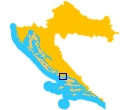Trogir
|
|
Trogir (Latin Tragurion, Italian Trał) is a historic town and harbour at the Adriatic coast in Croatia, in Split-Dalmatia county, 27 km west of Split, with population 10,907 (2001), total municipality population 13,322 (2001), positioned at 43:31N lat and 16:16E long.
The city's historic core is on the UNESCO world heritage list.
| Contents |
History
Trogir was founded by Greek colonists from the island of Vis in the 3rd century BC, and it developed into a major port in the Roman period. Sudden prosperity of Salona deprived Trogir of its importance. During the migration of Slavs the citizens of the destroyed Salona escaped to Trogir. From the 9th century Trogir was paying tribute to the Croatian rulers. The diocese of Trogir was established in the 11th century (abolished in 1828) and in 1107 it was chartered by the Hungarian-Croatian king Coloman, gaining thus its autonomy as a town.
In 1123 it was conquered and almost completely demolished by the Saracens. However, Trogir recovered in a short period to experience a powerful economic prosperity in the 12th and the 13th centuries. In 1242 King Bela IV found refuge there as he was running from the Tatars. In the 13th and the 14th centuries the members of the Šubić family were most frequently elected dukes by the citizens of Trogir; Mladen III (1348), according to the inscription on the sepulchral slab in the Cathedral of Trogir, called "the shield of the Croats", was one of the most prominent Šubićs.
In 1420 the period of a long-term Venetian rule began. On the fall of Venice in 1797 Trogir became a part of the Habsburg Empire which ruled over the city until the 1918, with the exception of French occupation from 1806 to 1814. After World War I, Trogir, together with Croatia, became a part of State of Slovenes, Croats and Serbs and subsequently Kingdom of Yugoslavia. During the World War II Trogir was occupied by Italy, and the citizens were mainly on the Allies' side and it was liberated 1944. Since then it belonged to the second Yugoslavia, and from 1991 to Croatia.
Trogir.jpg
Cultural heritage
Trogir has fascinating 2300 years of continuous urban tradition. Its rich culture is created under the influence of old Greeks, Romans, Venetians. Trogir has high concentration of palaces, churches, towers, fortress on a small island, inscribed in 1997 in the UNESCO World Heritage List. "The orthogonal street plan of this island settlement dates back to the Hellenistic period and it was embellished by successive rulers with many fine public and domestic buildings and fortifications. Its beautiful Romanesque churches are complemented by the outstanding Renaissance and Baroque buildings from the Venetian period", says UNESCO report.
Trogir is the best-preserved Romanesque-Gothic complex not only in the Adriatic but in all of Central Europe. Trogir's medieval core, surrounded by walls, comprises a preserved castle and tower and a series of dwellings and palaces from the Romanesque, Gothic, Renaissance and Baroque periods. Trogir's grandest building is the church of St. Lawrence, whose main west portal is a masterpiece by Radovan, and the most significant work of the Romanesque-Gothic style in Croatia.
The most important sites:
- Historical city core, with about 10 churches and numeous buildings from 13th century
- The city gate (17th cent.) and city walls (15th cent.)
- The Fortress Kamerlengo (15th century)
- The Duke's Palace (13th century)
- The cathedral of St. John. from the 13th century with the Portal of Master Radovan, the unique work of this great Croatian artist
- The big and small palaces Cipiko from the 15th century
- The city loggia from 15th century
Economy
Tourism is the most important economic branch in Trogir region covering 50% of city's budget with more than 20,000 beds in hotels and private apartments. There is also very strong fishing and agriculture tradition among population in surrounding areas.
The most important industry is shipbuilding, with shipyard "Trogir" made up at the beginnng of the last century. Shipyard has capacity of 2 ships of 55,000 tons. Between 1990 and 2004, 93 ships were built in the shipyard.
External links
- National Touristical Board (http://www.croatia.hr/destinations/destinations.aspx?id_destination=175)
- www.trogir-online.comde:Trogir

